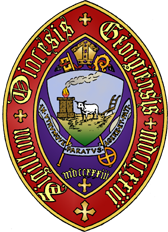As we approach the bicentennial of our founding in 2023, we will share the story of the Diocese of Georgia. This week we remember the three parishes who kickstarted the Diocese of Georgia.
Though Anglicans founded Georgia, no bishop visited the colony or state for its first 82 years. For much of that time, one had to travel to England for confirmation. Then in 1815, Christ Church in Savannah arranged for the second Bishop of South Carolina, Theodore Dehon, to consecrate their church and confirm 50 persons. His successor, Bishop Nathaniel Bowen, consecrated Saint Paul’s Church in Augusta in 1821, confirming persons there and again a few years later confirmed persons in Savannah.
 In February 1823, the three Episcopal congregations in Georgia–Christ Church in Savannah, Saint Paul’s in Augusta, and Christ Church Frederica on St. Simons Island–sent delegates to the first convention of what became the Protestant Episcopal Church in the State of Georgia. They celebrated the Eucharist together and prayed Morning Prayer daily through the February 24-28 convention. The delegates elected a Standing Committee, deputies to the General Convention of the Episcopal Church, and wrote the Constitution and Canons for the Diocese. They also founded “The Protestant Episcopal Society for the General Advancement of Christianity in the State of Georgia,” to reach destitute members in different parts of the state and arrange for the distribution of prayer books and religious tracts.
In February 1823, the three Episcopal congregations in Georgia–Christ Church in Savannah, Saint Paul’s in Augusta, and Christ Church Frederica on St. Simons Island–sent delegates to the first convention of what became the Protestant Episcopal Church in the State of Georgia. They celebrated the Eucharist together and prayed Morning Prayer daily through the February 24-28 convention. The delegates elected a Standing Committee, deputies to the General Convention of the Episcopal Church, and wrote the Constitution and Canons for the Diocese. They also founded “The Protestant Episcopal Society for the General Advancement of Christianity in the State of Georgia,” to reach destitute members in different parts of the state and arrange for the distribution of prayer books and religious tracts.
While a committee crafted the canons, another wrote an Address from the newly formed diocese of the Episcopal Church to send “to all the scattered members of that Church, throughout the State of Georgia.”
In the Address that was unanimously endorsed by the convention, they wrote of the Episcopal Church, “In herself she is worthy of your affection and support. Her ministry is apostolic, her constitution is primitive, her services are fervent and animated, yet chastened and reverential; her doctrines are the doctrines of the Bible, the doctrines of the Cross, her only object is the promotion of ‘pure and undefiled religion.’ Such, brethren, is the church in whose establishment we ask your aid.”
 The Address went on to say, “We are aware, brethren, that there are difficulties to be encountered. Your number is small, and the individuals composing that number, are perhaps scattered. But be not disheartened. These obstacles are not insurmountable….However small, then, be your number in each vicinity, let that small number be embodied.”
The Address went on to say, “We are aware, brethren, that there are difficulties to be encountered. Your number is small, and the individuals composing that number, are perhaps scattered. But be not disheartened. These obstacles are not insurmountable….However small, then, be your number in each vicinity, let that small number be embodied.”
The population of the State in 1823, was approximately 390,000 and there were 131 Episcopal parishioners or one Episcopalian to nearly 3,000 Georgians. For comparison, the US Census for 2020 names Georgia’s population at 10,711,908 and parochial reports for the Diocese of Georgia and Atlanta for the same year list 59,010 parishioners, so that 1 in every 182 Georgians was an Episcopalian that year.
 After the Diocese of Georgia was organized, the South Carolina Bishop presided at Georgia Conventions until a Bishop was elected for Georgia. It would be two years before the Diocese would add its fourth congregation, Christ Church in Macon. At that 1825 meeting, they noted in the minutes a letter from the Honorable C.B. Strong of Macon that said, “You know, by the short tour you have made through the State, the forlorn and scattered situation of the almost lost sheep of our flock—their destitute and bewildered condition; and how little is known of our holy faith and sublime mode of worship….These considerations prompt me to entreat you to use your greatest exertions to induce the Convention, either by application to the General Convention, or in some other way, to procure one Missionary or more, to preach in this State.”
After the Diocese of Georgia was organized, the South Carolina Bishop presided at Georgia Conventions until a Bishop was elected for Georgia. It would be two years before the Diocese would add its fourth congregation, Christ Church in Macon. At that 1825 meeting, they noted in the minutes a letter from the Honorable C.B. Strong of Macon that said, “You know, by the short tour you have made through the State, the forlorn and scattered situation of the almost lost sheep of our flock—their destitute and bewildered condition; and how little is known of our holy faith and sublime mode of worship….These considerations prompt me to entreat you to use your greatest exertions to induce the Convention, either by application to the General Convention, or in some other way, to procure one Missionary or more, to preach in this State.”
These efforts would be successful as the State of Georgia became a missionary field for the Episcopal Church and would remain so for many years with outside support essential to calling clergy and to enable further expansion into new areas.
Pictured above: Saint Paul’s in Augusta, Christ Church in Savannah, and Christ Church Frederica on St. Simons Island.
